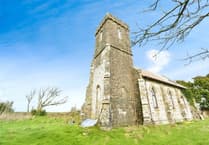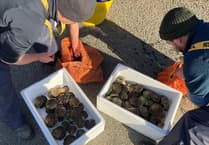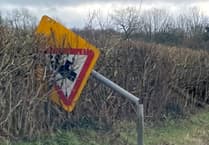Life in the prefabs
It may come as a surprise to many that I was not born in Pembroke. Born in Tenby was I, but I spent much of my working life here: I was community librarian for Pembroke and Pembroke Dock for many years and this led to my interest in our history.
However, I do have a great affection for Tenby where I spent my earliest years in Heywood Court, site of a post-war prefab estate.
What has this to do with the history of Pembroke and Pembroke Dock?
Well, the prefabs were the very first council houses to be built here in around 1947 and. therefore. represent an important chapter in our social history. Young 'uns reading this will not know what I am talking about so, to give a little bit of background, prefab is short for the prefabricated houses which were built in large numbers after the Second World War.
Like so many young couples, married and starting families at that time, my parents lived in over-crowded conditions sharing with the in-laws. It was to provide a quick solution to this problem that the prefabs (by which name they became universally known) were built, a result of the 1944 Temporary Housing Programme.
Pembroke prefabs
A couple of years ago, I wrote about life in the prefabs for 'Pembrokeshire Life', which was partly written as an appeal for information about the Pembroke prefabs, as I had no photographs of them.
I knew they were built in Jogram Avenue (Britannia Avenue, Bufferland in Pembroke Dock), but I had at that point been unsuccessful in my quest for photos.
Testament to the affection people still feel for these little dwellings, I received many phone calls from all over the place and struck lucky when Peter Dawkins rang and told me he had some photographs.
I knew Pete from schooldays in Greenhill, but his uncle Johnny Dawkins, a well-known Pembroke man, lived in Jogram Avenue with his wife Margaret, and Peter would often stay with them.
All mod cons
Prefabs may not look much to the modern eye, but they were they very well designed two-bedroom bungalows and for their time they represented modern living.
There was a fitted kitchen, complete with cooker, boiler and fridge (a luxury at this time), running hot water, a proper bathroom with indoor toilet.
There was electric lighting and built-in cupboards, drawers, wardrobes and a large airing cupboard: all you needed to buy were beds and living room furniture.
Many people didn't have electricity at this time, let alone electrical appliances, and outside loos were common.
I have to say the prefabs were cold in winter, though, and winter evenings saw the whole family huddled around the coal fire. Pre central heating, in winter we shivered in our bedrooms, awaking to find that Jack Frost painted his icy patterns on the windows! I was thinking about this in the cold snap we are experiencing at the moment - anyone living in those sort of conditions today would be regarded as living in deprivation! How times have changed.
With kids in mind
What was so marvellous to us as children was the fact that the prefabs were designed for young families. Peter remembers the large gardens with plenty of space to grow fruit and vegetables and good family get-togethers in the garden - in one of the photographs you can see Johnny and Margaret Dawkins with relatives and a very young Peter in the foreground.
I met a fellow prefab kid recently - Keith Wheeler, who was born in one of the Pembroke prefabs. (It was the norm then to be born at home: the doctor was always there when you needed him to call, and was looked on as a family friend. Can you imagine that now?)
It was good to reminisce as Keith, like myself, had a thoroughly great time growing up in the prefabs. Like Keith said, we didn't have much money, but after the war we were all in the same boat. Whether it be in Tenby or in Pembroke, we as children had similar experiences and enjoyed ourselves in much the same way, making up our own games and entertainment.
"At the back of the prefabs was a bank," Keith remembered, "where we had a rope swing and we used to swing out across the Commons road when cars came by. We would play in the park and climb trees. And at the bottom of Paynter Street there used to be an area of open land where we would build a bonfire for Bonfire Night.
"We would cut down trees in Colley's fields to build the fire, along with tractor tyres, rubbish and newspapers, leaving a space inside to keep guard as other kids would carry out raids on the bonfire before November 5!"
Guy Fawkes Night was much more of an occasion then; 'penny for the guy' is another thing of the past.
Compared to the present generation of children, we didn't have much and the prized possession was a bike. I've included one of my photographs here as it shows me on a trike (remember them?) - solid little three-wheelers which you only fell off if you whizzed around the corners too fast, as you did.
My sister is on a 'Hercules', which I later inherited when she outgrew it; don't think I ever had a new bike. Keith, however, used to make his own. " If we wanted a bike," he told me, "we would hunt in Frankie Collins's scrapyard on Lower Lamphey Road to find a frame, wheels and tyres to build our own bikes and gadges (go-karts). That is why we were all so practical."
The end
Prefabs were only made to last 10 years, but they still exist in some places. The Tenby ones were taken down in the early '60s, but in Pembroke they lasted until 1978. There is even a prefab in St. Fagan's now. The exterior is different to the ones built in Pembroke, Pembroke Dock and Tenby. Ours were built around a tubular steel frame, with corrugated asbestos cement cladding (the Arcon Mark V), while the St. Fagan's example is an Aluminium Type B2. The internal layout is similar.
Although long gone now, the prefabs will not be forgotten. Keith is taking part in our project 'Through My Eyes: a community history of Pembroke and Monkton', which is attempting to capture past times in Pembroke in a series of digital stories or short films which, when completed, will be available on a dvd and book. His story is about growing up in Orange Gardens where he began life in a prefab in Jogram Avenue.
Contact
If you have any stories, photographs or feedback for this column, please contact me, Linda Asman, on 01646 622428, email [email protected]">[email protected] and visit our website http://www.pembrokeandmonkonhistory.org.uk">www.pembrokeandmonkonhistory.org.uk
Next event
This (Friday) evening, Quiz Night at Monkton Priory Church Hall, 7.30 pm.
£3.50 includes a buffet; coffee and tea included, but bring your own bottle if you wish.




